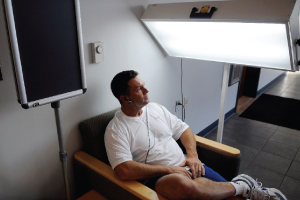By Brenda Campbell, LICSW
Nov. 25, 2019
 U.S. Air Force photo by/Airman 1st Class Yash Rojas
U.S. Air Force photo by/Airman 1st Class Yash Rojas
The days are now shorter, the temperature is colder, and the winter solstice is still weeks away. You may be starting to notice patients coming in and complaining of decreased mood and lethargy. Is it the beginning of a cold? Or the "winter blues"? Or might they be suffering from seasonal depression? The Diagnostic and Statistical Manual of Mental Disorders, Fifth Edition (DSM-5), refers to seasonal depression as major depressive disorder with seasonal pattern.
For patients who have some symptoms of lethargy or decreased mood but are otherwise able to function and enjoy their usual activities, they may just be adjusting to the colder, darker months as many people do. But for those who indicate they are having trouble functioning at work or in their relationships, or have symptoms of hypersomnia, overeating, or social withdrawal, they may be experiencing seasonal affective problems.
Seasonal affective disorder is a type of depression that is typically experienced in the fall and winter months. Some risk factors include if individuals:
- Live further away from the equator
- Suffer from depression or bipolar disorder
- Have a family history of depression
- Are female
If you have a patient presenting with depressive symptoms, take the following steps:
- Get a history of mental health issues.
- Track the time of year of onset of symptoms and ask if this has happened in previous years.
- Ask whether these symptoms have abated when the seasons changes to warmer and longer days.
- Ask about their last medical visit for a check-up as some of these symptoms could be attributed to medical conditions, including hypothyroidism or anemia. Consider recommending a visit for blood work to rule out these and other medical conditions.
Just as you would treat others forms of depression, the recommended treatment options including talk therapy, medication, or a combination of the two, are available. In addition, light therapy has shown some promising results. While the evidence on the effectiveness of using light therapy is limited, the risks of trying this intervention are low. It is important to ensure the patient follow the correct light exposure and intensity. According to the VA/DOD Clinical Practice Guideline for The Management of Major Depressive Disorder, using 6,000 to 10,000 LUX for 30 to 60 minutes a day has shown some short term favorable results in most trials.
Importantly, if your patient indicates any thoughts of harming themselves or others, please contact emergency support.
On a positive note, once Dec. 21 (the shortest day of the year) arrives, it is all downhill towards warmer weather and more daylight, a few minutes at a time.
Ms. Campbell is a contracted licensed independent clinical social worker on the evidence-based practice team at the Psychological Health Center of Excellence. She has a master's degree in social work and has been working with service members, veterans, and their families for nearly a decade.